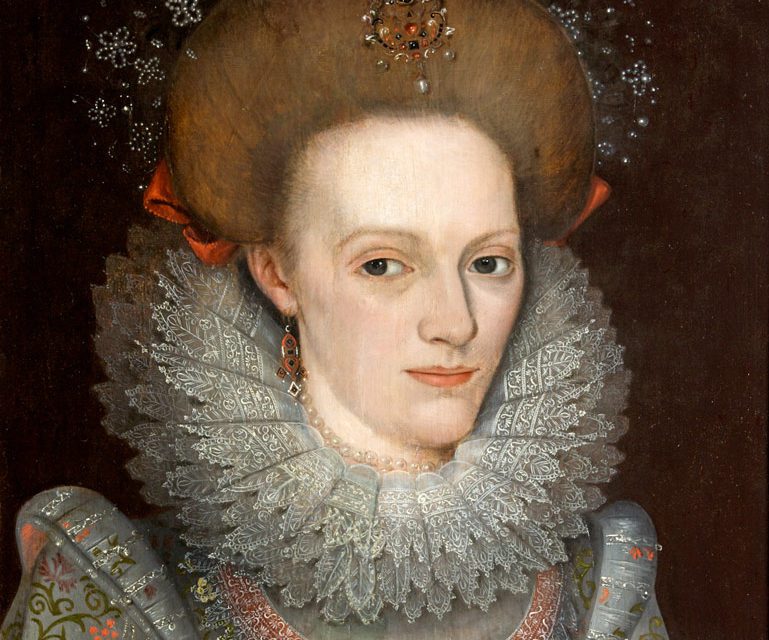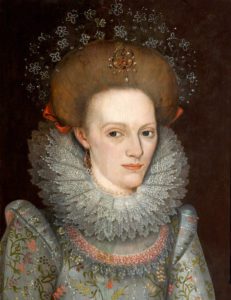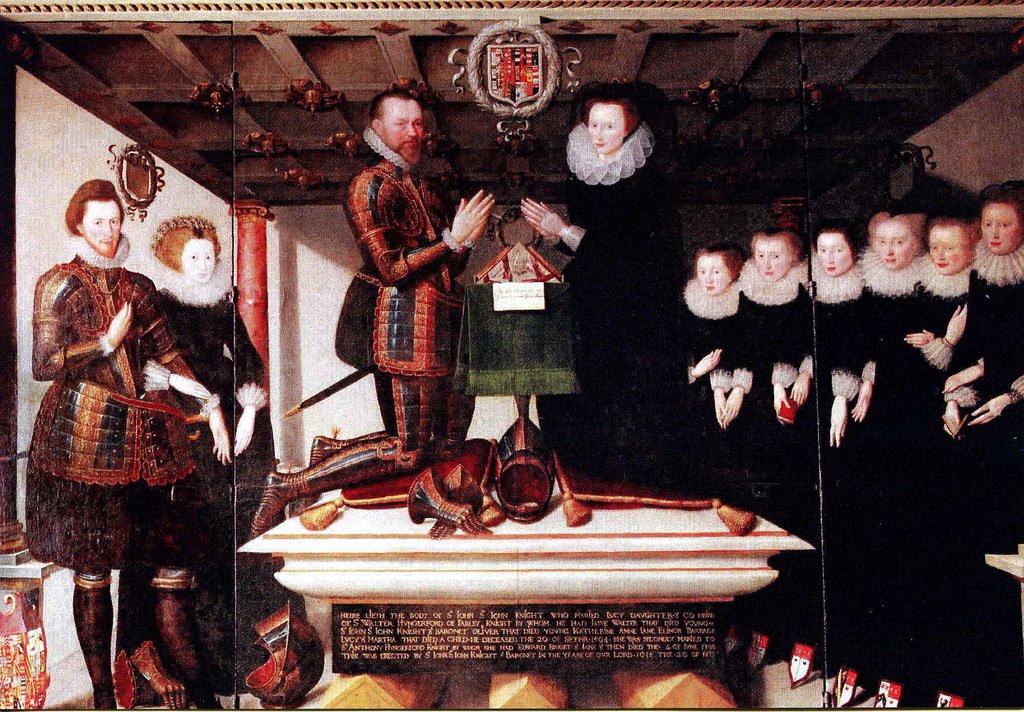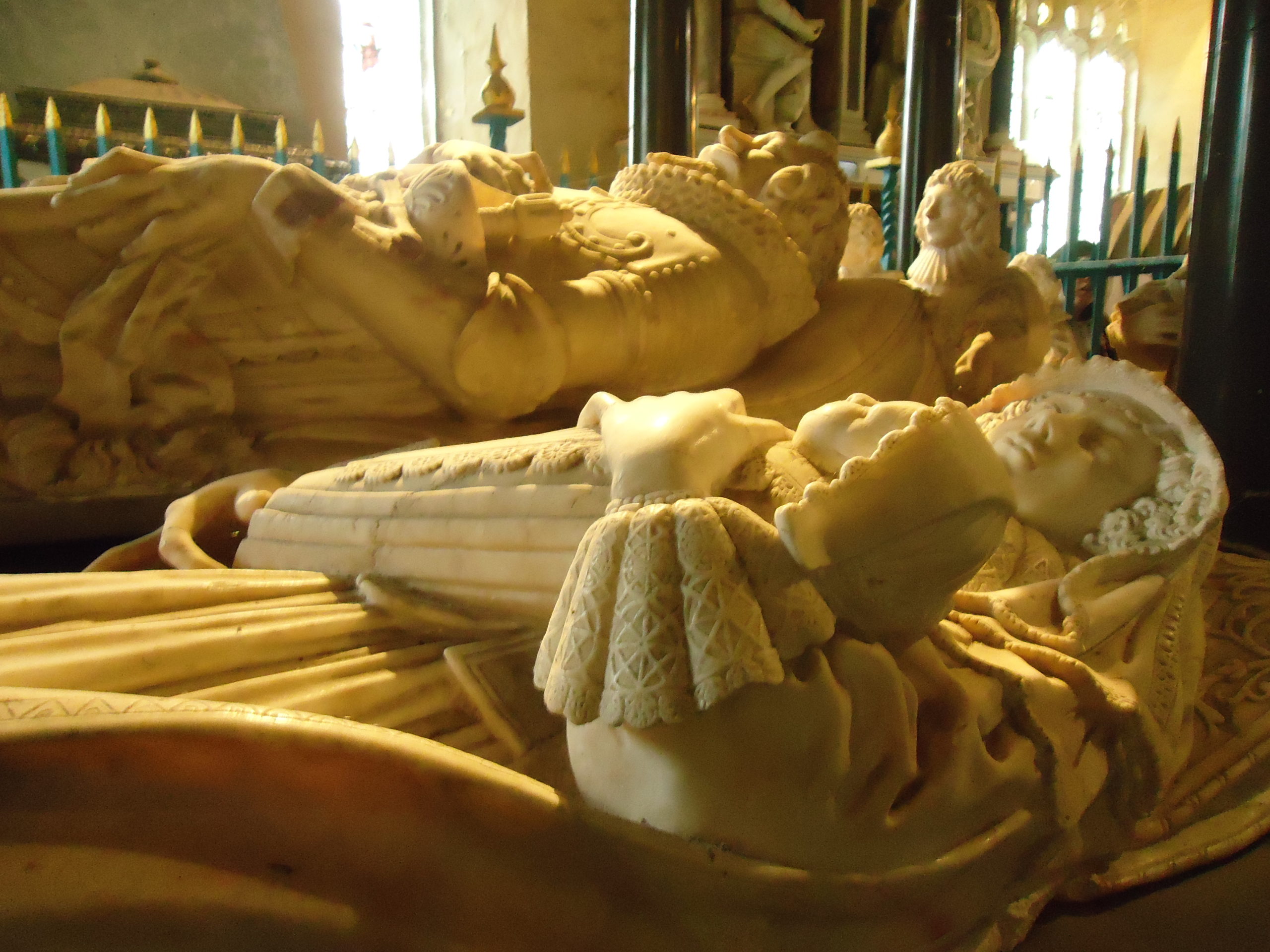

Anne Leighton grew up during the volatile period of political intrigue and religious fervour that marked the end of the Tudor period and the beginning of the Stuart. The daughter of professional soldier Sir Thomas Leighton and Elizabeth Knollys, who shared a Boleyn ancestry with Queen Elizabeth I, Anne was the first wife of Sir John St. John 1st Baronet.

Anne was christened on October 14, 1591 at the parish church of St. Mary the Virgin, Hanbury. Four miles from Droitwich, Hanbury in Worcestershire was the Leighton family seat. However it is likely she spent some of her childhood in Guernsey where her father was appointed Governor in 1570 and some at the court.
With her royal pedigree and wealthy background Anne received an education befitting her status. Along with her brother Thomas and sister Elizabeth, Anne was educated by the controversial, uncompromising, Puritan preacher, William Bradshaw. The girls also received instruction in the skills required for running their own establishments.
The association between the Leighton and St. John families was a long standing one. John St John and his siblings were orphaned in childhood. After their father’s death in 1594, their mother Lucy married her cousin Sir Anthony Hungerford of Black Bourton. Following her death in 1598 the heir to the St John estates was made a ward of the monarch.
Queen Elizabeth granted Sir Thomas Leighton the wardship of the young John St. John and the lease of his lands after an appeal from Lady Elizabeth Leighton who stated that she and her husband were ‘minded to match him to their daughter.’
Sadly, whilst on holiday with Sir Thomas in 1597 John’s elder brother Walter got into difficulties bathing off the Island of Herm with a group of fellow young guests. His tutor Isaac Daubney went to his aid, but both were drowned. John subsequently succeeded to the family estate, aged just 11 years old.
Anne married John at St. John’s Church, Hackney on July 9, 1604. Still a ward of court, John was 19 years old. With no legal age for marriage, Anne was just 13.
It is not known when the young couple first set up home together, although the daughter of Sir John’s sister Lucy St John suggests it was soon after their marriage.
“The rest of my aunts, my mother’s sisters, were dispersed to several places, when they grew up till my uncle, Sir John St. John, being married to the daughter of Sir Thomas Laten, they were all again brought home to their brother’s house,” Lucy Hutchinson writes in her Memoirs of Colonel Hutchinson.
Lucy also writes of the kindness shown by Anne to her mother, the youngest of six sisters among whom there was considerable rivalry in the matrimonial stakes – “my uncle’s wife, who had a mother’s kindnesse for her, persuaded her to remove herselfe from her sister’s envie, by going along with her to the Isle of Jernsey where her father was governor.”
The St. John family was the largest landowners in the 17th century parish of Lydiard Tregoze with the medieval deer park, numerous farms including Windmill Leaze and Wick, plus others at Shaw and parcels of land in the neighbouring parish of Lydiard Millicent.
In 1604 the medieval mansion house to which the newly married couple returned consisted of two wings linked by a central hall block. This was a period when a number of titled families were renovating their ancestral homes and in many instances it was the lady of the house who was in charge of building operations. Perhaps Anne was the driving force behind the modernisation of Lydiard House, dragging it out of the past and into the 17th century. The remodelled Palladian house as seen today was the work of her great grandson John, 2nd Viscount St. John.
Unlike subsequent members of the family who divided their time between their various establishments, the Lydiard mansion was the permanent home of John and Anne. These were busy times for the young couple and their growing family. Knighted at Whitehall on February 2, 1608/9, Sir John became one of newly crowned James I’s Baronets in 1611.
The St. John’s had status, wealth and connections. The family finances were secure. These, it might be said, were the golden years.
The ladies at Lydiard kept up with the fashion of the day as this extract from a London dressmaker’s bill indicates. The total cost for items for Anne, her two daughters Anne aged 15 and Barbara eleven years old and a Mistress Talbot came to £12 17s 5d, presented for payment after Anne’s death in 1628.
The Lady St. Johns of Lideard the 28 of March 1629
For Canvas stifning and whalbone for Mistress Ans grene and white flowered grogram goune
for fustyan to lyne the sleves and Clasps
for a yeard of Crimson and silver grogram for the same goune
for a norme and quarter of new silver lan[…]
for the bodis and sleves
for faring for the same goune
for silke
There are three representations of Anne at Lydiard House and Park. A portrait by an artist thought to be Gilbert Jackson hangs in the dining room. Dressed in fashions typical of the period, Anne wears a grey dress with epaulettes, embroidered in green, red and gold and a deep lace collar edged with red and gold embroidery. Her hairstyle owes more to the Elizabethan period worn swept back from her face with a pendant inset and earrings to match. She has a kindly expression, unlike the severe looking Margaret Whitmore, Sir John’s second wife, whose portrait hangs above the one of Anne.
Anne also appears in the St. John Polyptych that stands in St. Mary’s Church, next to the mansion house. Commissioned by Sir John in 1615, the painting is a celebration of the St. John ancestry and a memorial to his parents, Sir John and Lucy who take centre stage, kneeling on a tomb. To the right of the family portrait are their six daughters while to the left stand the younger Sir John and Anne, their arms interlinked in a display of informality and intimacy.

Anne did not live to see the turmoil of the Civil War in which five of her sons played an active role. The first of Anne’s three sons to die for the Royalist cause was William born 1617, killed in action at nearby Cirencester. A lieutenant in the infantry, William was fighting alongside Prince Rupert when Cirencester was seized on February 2 1642/3. His body was returned to Lydiard House where he was buried alongside his mother in the family vault at St. Mary’s.
Later the same year, John, Anne’s second son, died fighting in Nottinghamshire. The Royal garrison at Newark was blockaded during the winter of 1643 and it is believed that John was killed during fierce fighting. He was buried in the chancel of the parish church at Newark.
The third of Anne’s sons to die fighting in the Royalist ranks was Edward. A captain in Sir John Byron’s Regiment of Horse, Edward saw action at the Second Battle of Newbury on October 27 1644. He returned to Lydiard House where fatally wounded he lingered on, eventually dying of his injuries over five months later. He was also buried in the family vault at St. Mary’s.
Anne’s two youngest sons Walter and Henry both married daughters of Cromwellian sympathiser Oliver St. John, Chief Justice of the Common Pleas, nailing their colours firmly to the Parliamentarian mast.
Finally, an effigy of Anne can be seen on the magnificent alabaster St. John tomb commissioned by Sir John fourteen years before his actual death. The carving is of the highest quality and a comparison with existing portraits confirms the accuracy of the representations of Sir John and his two wives.

The inscription reads: “Anne was the daughter of Thomas Leighton, Knight, by his wife Elizabeth of the Knowles family and of the kindred of Queen Elizabeth, as blessed in character as in connection. She lived for thirty seven years, endowed with noble gifts of mind, body, and manner, a rare example of virtue and piety; she was the mother of thirteen surviving children; in the end, long worn down by the painful agonies of her last confinement and at last overcome, she fled to heaven on the 19th September, 1638.”
The date is incorrectly recorded and should read 1628.
Critically acclaimed historical novelist, Elizabeth St. John, traces her ancestry back to Margaret Beauchamp, Duchess of Somerset who married firstly Sir Oliver St. John. Elizabeth’s novels include The Lady of the Tower, By Love Divided and Written in Their Stars (known collectively as The Lydiard Chronicles); The Godmother’s Secret and the recently published The King’s Intelligencer, all available from Amazon